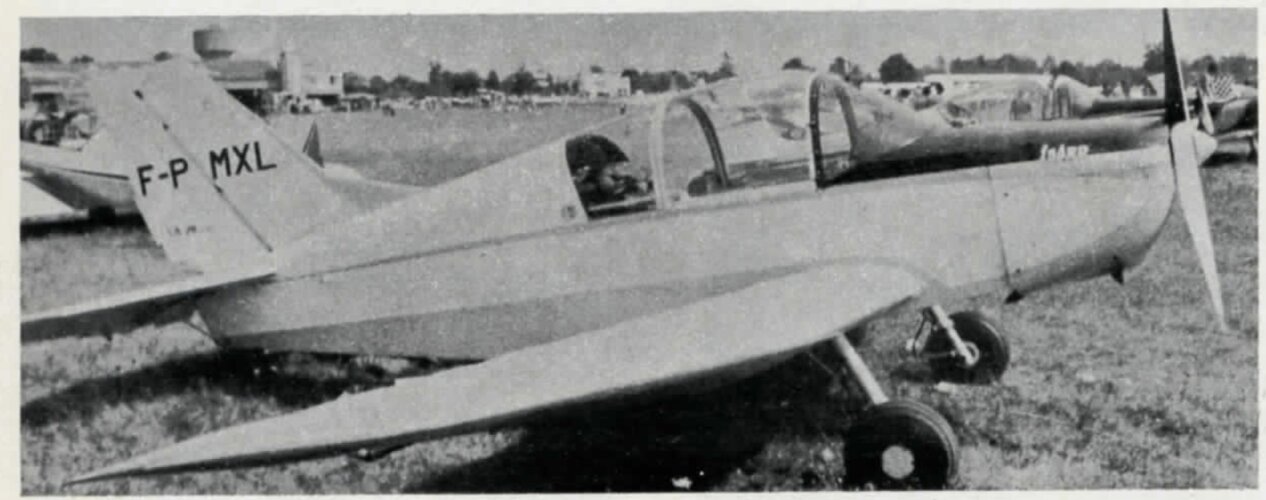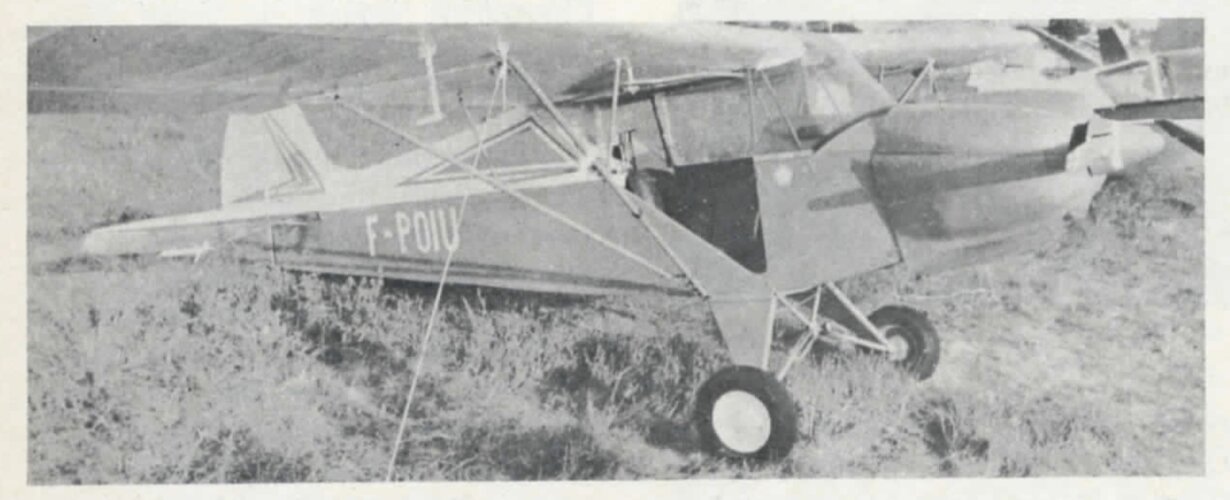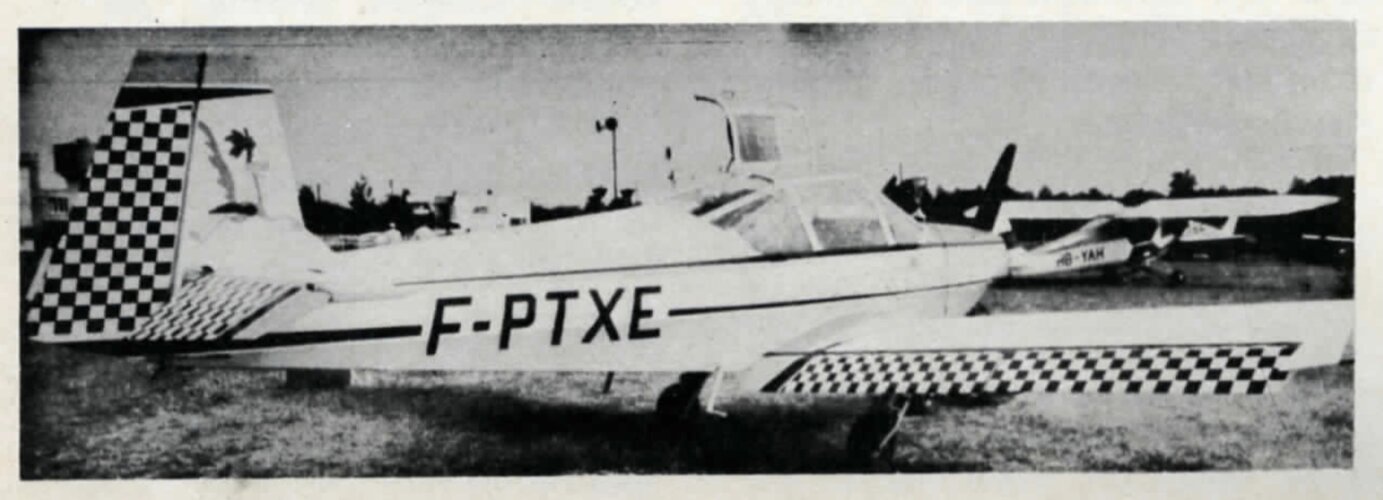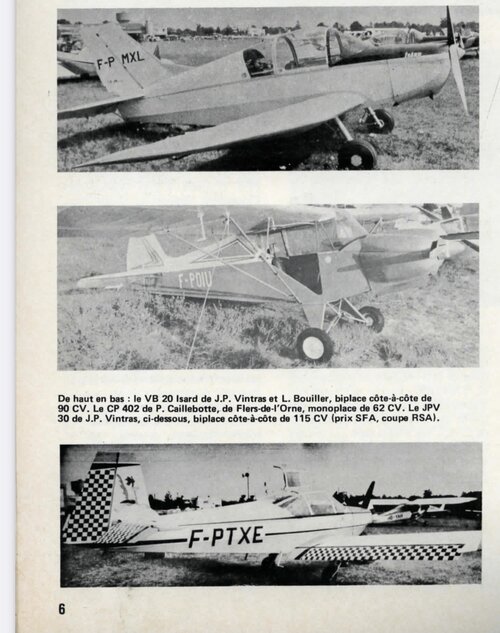You are using an out of date browser. It may not display this or other websites correctly.
You should upgrade or use an alternative browser.
You should upgrade or use an alternative browser.
French Light Civil Aircraft & Helicopter Projects and Prototypes
- Thread starter hesham
- Start date
- Joined
- 26 May 2006
- Messages
- 34,800
- Reaction score
- 15,685
Hi Hesham!
In your text it says "engine not specified". AFAIK the JP-31 was a projected variant of the JP-30 with 160hp Lycoming O-320. but it was never built.
You was right my dear Walter,and from Aviation magazine 1964.
Attachments
- Joined
- 26 May 2006
- Messages
- 34,800
- Reaction score
- 15,685
What is written?
You are right;
J. POULLIN (PROJECT). - Jean Poullin, which we know he realized,a
few years ago, a small two-seater for tourism called Globe-Trotter,
then a single-seater powder (agricultural) JP-30. had failed to produce
the JP-31 version, more powerful. evolved from the latter. He works
currently planning a new powder aircraft, including the central engine,
a 90hp Continental C-90,would cause two large propellers lateral
diameter driven by belts.
That means he designed anther Project as agricultural aircraft,powered
by single engine,driven a two propellers,right ?.
Last edited:
- Joined
- 26 May 2006
- Messages
- 34,800
- Reaction score
- 15,685
Aubi
ACCESS: Secret
JPV.30 is a biplace side-by-side trainer. JPV.30 is a tri-place utility airplane. Two JPV.40s are mentioned as being built by amateur builders. One JPV.50, high-wing derivative of JPV.40, is being built too.
Dear Hesham!
The P-40 was actually built and AFAIK 2 examples were completed, one in France (F-PBYF) and one in Belgium (OO-68). Attached a photo of the one in France.
Also some text:
single-seat sport
No.1: one 25hp VW1200 piston engine
max. speed 113 mph, cruise 98 mph, ceiling 9,500ft, range 375 miles
wingspan 19.695ft; length 8.530ft; height 3.936ft
DETAILS: The P-40 was an original design (Mr. Jean Pottier's first to be built) homebuilt aircraft and featuring a flying wing configuration. Development already started in 1968, but it was until 1976 (1975?) that the first P-40 was flown. This aircraft, which reportedly only made one brief flight and which was destroyed in an accident on the maiden flight, was built in France, by Mr. Bela Nogrady with one 25hp VW1200 engine. A second example was built in Belgium (OO-68) and that aircraft later joined the Brussels Military Museum (Musée Royale de l’Armée et d’Histoire Militaire Bruxelles) collection. No further aircraft of the type were built and Mr. Pottier concentrated on more conventional designs such as the P-70, P-80 etc.
Production: 2
The P-40 was actually built and AFAIK 2 examples were completed, one in France (F-PBYF) and one in Belgium (OO-68). Attached a photo of the one in France.
Also some text:
single-seat sport
No.1: one 25hp VW1200 piston engine
max. speed 113 mph, cruise 98 mph, ceiling 9,500ft, range 375 miles
wingspan 19.695ft; length 8.530ft; height 3.936ft
DETAILS: The P-40 was an original design (Mr. Jean Pottier's first to be built) homebuilt aircraft and featuring a flying wing configuration. Development already started in 1968, but it was until 1976 (1975?) that the first P-40 was flown. This aircraft, which reportedly only made one brief flight and which was destroyed in an accident on the maiden flight, was built in France, by Mr. Bela Nogrady with one 25hp VW1200 engine. A second example was built in Belgium (OO-68) and that aircraft later joined the Brussels Military Museum (Musée Royale de l’Armée et d’Histoire Militaire Bruxelles) collection. No further aircraft of the type were built and Mr. Pottier concentrated on more conventional designs such as the P-70, P-80 etc.
Production: 2
Attachments
Retrofit
ACCESS: Top Secret
- Joined
- 21 February 2007
- Messages
- 656
- Reaction score
- 336
Dear Hesham!
The P-40 was actually built and AFAIK 2 examples were completed, one in France (F-PBYF) and one in Belgium (OO-68). Attached a photo of the one in France.
Also some text:
single-seat sport
No.1: one 25hp VW1200 piston engine
max. speed 113 mph, cruise 98 mph, ceiling 9,500ft, range 375 miles
wingspan 19.695ft; length 8.530ft; height 3.936ft
DETAILS: The P-40 was an original design (Mr. Jean Pottier's first to be built) homebuilt aircraft and featuring a flying wing configuration. Development already started in 1968, but it was until 1976 (1975?) that the first P-40 was flown. This aircraft, which reportedly only made one brief flight and which was destroyed in an accident on the maiden flight, was built in France, by Mr. Bela Nogrady with one 25hp VW1200 engine. A second example was built in Belgium (OO-68) and that aircraft later joined the Brussels Military Museum (Musée Royale de l’Armée et d’Histoire Militaire Bruxelles) collection. No further aircraft of the type were built and Mr. Pottier concentrated on more conventional designs such as the P-70, P-80 etc.
Production: 2
Photo of the second example on show at Brussels Military Museum.
This P-40 was built by Jean d’Otreppe de Bouvette.
Attachments
- Joined
- 26 May 2006
- Messages
- 34,800
- Reaction score
- 15,685
- Joined
- 26 May 2006
- Messages
- 34,800
- Reaction score
- 15,685
Hi,
here is a helicopter from 1954,designed by Mr. Guy Delannoy,called JDA-01.

http://kulturserver-nds.de/home/hubtest/medien/Typenkartei3953xGUN7x9T3Z7.pdf
here is a helicopter from 1954,designed by Mr. Guy Delannoy,called JDA-01.
Stingray's Rotorcraft Forum
Discussion forum about helicopters and other rotorcraft - a part of the world's largest rotorcraft archive, "Stingray's List of Rotorcraft"
stingraysrotorforum.activeboard.com
http://kulturserver-nds.de/home/hubtest/medien/Typenkartei3953xGUN7x9T3Z7.pdf
Attachments
- Joined
- 26 May 2006
- Messages
- 34,800
- Reaction score
- 15,685
From Georges Messier's site;
the Société d'Atude et de Construction Aéronavale Le Grix in
Marseille associated with AVIA to produce a number of its gliders
and sailplanes,this Info from TU magazine,but they also mentioned
that,there was a few Projects,but no details are known about them,
and maybe they were contained a normal aircraft,such like this,Le
Grix LG-40 ?,as I think,who heard about it ?.
 www.acam.asso.fr
www.acam.asso.fr
the Société d'Atude et de Construction Aéronavale Le Grix in
Marseille associated with AVIA to produce a number of its gliders
and sailplanes,this Info from TU magazine,but they also mentioned
that,there was a few Projects,but no details are known about them,
and maybe they were contained a normal aircraft,such like this,Le
Grix LG-40 ?,as I think,who heard about it ?.
¤ A C A M ¤ Association des anCiens et des Actifs des sociétés Messier
acam, Association des anCiens et des Actifs des sociétés Messier
Attachments
Last edited:
fabulousfour
ACCESS: Confidential
- Joined
- 20 October 2009
- Messages
- 74
- Reaction score
- 134
fabulousfour
ACCESS: Confidential
- Joined
- 20 October 2009
- Messages
- 74
- Reaction score
- 134
fabulousfour
ACCESS: Confidential
- Joined
- 20 October 2009
- Messages
- 74
- Reaction score
- 134
fabulousfour
ACCESS: Confidential
- Joined
- 20 October 2009
- Messages
- 74
- Reaction score
- 134
www.All-Aero.com is in awe at the knowledge, and ability to locate (and read French) such rare and obscure aircraft.
Wish you guys wold contribute to All-Aero
Wish you guys wold contribute to All-Aero
- Joined
- 26 May 2006
- Messages
- 34,800
- Reaction score
- 15,685
From Aviation magazine 1963,
the first time to know Gazuit had a Project for twin engined high-wing light monoplane ?.
Was it the same company ?,here;

Gazuit-Valladeau GV-1020 - Wikipedia
- Joined
- 25 July 2007
- Messages
- 4,297
- Reaction score
- 4,183
From Aviation magazine 1963,
the first time to know Gazuit had a Project for twin engined high-wing light monoplane ?.
Was it the same company ?,here;

Gazuit-Valladeau GV-1020 - Wikipedia
en.wikipedia.org
Not the same firm but the same designer - Georges Gazuit. He teamed up with Valladeau later - Etablissements Roger Valladeau in Gueret-Saint-Laurent (Creuse) seems to have been building Jodels.
Hoping that this is not too off topic. In mid-1970, a Montréal, Québec, company founded that same year, Mondair Aviation, announced plans to produce the Gazuit-Valladeau GV-103 Gazelle, a French three-seat private aircraft flight tested in 1969. The company intended to build a $ 3 million factory in Sherbrooke, Québec, which would export the bulk (up to 80%) of its production. This factory would eventually employ 150 or so people. Mondair Aviation was confident it could undersell its competitors. A consortium of four European companies would oversee the sale of the Québec-made machines - 400 or so during the first year after the inauguration of the factory it was said.
The firm's choice of location resulted from the fact that Sherbrooke and its region were among the special zones designated as such by the federal government. Indeed, Mondair Aviation hoped to obtain a grant from Regional Economic Expansion Canada to finance the construction of the plant. The granting of that sum of money, however, depended on the conclusion of arrangements with Canadian and European interests.
Mondair Aviation's project evolved over time, possibly as a result of a visit to Sherbrooke made by the engineer Georges Gazuit, in November 1970. In any event, the firm got a subsidy of almost $ 425 000 in March 1971. It claimed to have 600 or so orders on hand. By the spring of 1971, Mondair Aviation also wanted to produce the Gazuit-Valladeau GV-1020 two-seater and GV-1031 four-seater. Also possibly known as Gazelles, these aircraft were flight tested in 1971 and 1974 (?). Mondair Aviation allegedly purchased the worldwide production rights for the GV-103, GV-1020 and GV-1031, which were renamed Mondair 115, 130 and 150.
Interestingly, Mondair Aviation indicated it intended to enter the prototype of the Mondair 150 in the London to Victoria, British Columbia, air race held in July 1971 - if that aircraft could be spared for the duration of the event. That did not happen.
Mondair Aviation was said to be a subsidiary of Canidec, a Montréal management company. The truth was that both companies were pretty much one and the same, and there was not much to either of them. By the spring of 1972, the big advertising panel put up near Sherbrooke's small airport was showing signs of wear and tear.
Mondair Aviation having failed to obtain the necessary funds, it had to give up its projects. Both it and Canidec faded into the sunset. That said, a Gazelle had been shipped to Canada / Québec but seemingly did not fly there.
The firm's choice of location resulted from the fact that Sherbrooke and its region were among the special zones designated as such by the federal government. Indeed, Mondair Aviation hoped to obtain a grant from Regional Economic Expansion Canada to finance the construction of the plant. The granting of that sum of money, however, depended on the conclusion of arrangements with Canadian and European interests.
Mondair Aviation's project evolved over time, possibly as a result of a visit to Sherbrooke made by the engineer Georges Gazuit, in November 1970. In any event, the firm got a subsidy of almost $ 425 000 in March 1971. It claimed to have 600 or so orders on hand. By the spring of 1971, Mondair Aviation also wanted to produce the Gazuit-Valladeau GV-1020 two-seater and GV-1031 four-seater. Also possibly known as Gazelles, these aircraft were flight tested in 1971 and 1974 (?). Mondair Aviation allegedly purchased the worldwide production rights for the GV-103, GV-1020 and GV-1031, which were renamed Mondair 115, 130 and 150.
Interestingly, Mondair Aviation indicated it intended to enter the prototype of the Mondair 150 in the London to Victoria, British Columbia, air race held in July 1971 - if that aircraft could be spared for the duration of the event. That did not happen.
Mondair Aviation was said to be a subsidiary of Canidec, a Montréal management company. The truth was that both companies were pretty much one and the same, and there was not much to either of them. By the spring of 1972, the big advertising panel put up near Sherbrooke's small airport was showing signs of wear and tear.
Mondair Aviation having failed to obtain the necessary funds, it had to give up its projects. Both it and Canidec faded into the sunset. That said, a Gazelle had been shipped to Canada / Québec but seemingly did not fly there.
- Joined
- 11 March 2012
- Messages
- 3,244
- Reaction score
- 3,170
I guess that sign fell down, because I do not remember it from the winter of 1977 -1978 when I visited Sherbrooke Airport dozens of times in the process of earning my private pilot license.
Nor do I remember hearing anything about the project in the print or electronic media.
There were numerous similar production proposals throughout Canada, but all depended upon massive infusions of federal money to get the projects off the ground. Little federal money was invested in small aircraft production.
Nor do I remember hearing anything about the project in the print or electronic media.
There were numerous similar production proposals throughout Canada, but all depended upon massive infusions of federal money to get the projects off the ground. Little federal money was invested in small aircraft production.
- Joined
- 25 July 2007
- Messages
- 4,297
- Reaction score
- 4,183
riggerrob: An article about Mondair Aviation appeared in The Sherbrooke Record on 29 May 1970 (although the company wasn't incorporated - as Federal Corporation #521574 - until 09 July 1970). Paul Rivard - the President of Mondair Aviation Ltd. - was announcing plans to produce 400 aircraft in Sherbrooke during 1970.
This article said that "plans are on the drawing board for a full line of aircraft, including four-place, six-place and twin-engined models" - all Gazuit-Valladeau designs as fortrena has noted..
On 29 July 1970, La Tribune noted that "le président de la compagnie Mondair, M. Paul Rivard, celui-là même qui projette l'établissement d’une avionnerie civile à l’aéroport municipal de Sherbrooke, est le neveu de Me Albert Rivard, l’ ex-procureur en chef de la cité de Sherbrooke."
'Me' is the French abbreviation for Maitre (avocat) - in this case a prosecutor. La Tribune detects a whiff of depotism but stops short of accusing Rivard of any wrong-doing - probably wise since Oncle Albert is a lawyer). Whatever they were trying to fling doesn't seem to have stuck.
On 23 Nov. 1972 a photo appeared in the The Sherbrooke Record of Rivard with Georges Gazuit. Also in attendance were Sherbrooke Mayor Marc Bureau and Liberal MP Paul Mullins Gervais (another 'Me'). No article accompanied the image but obviously the earlier La Tribune innuendo hadn't taken the shine off of Rivard for the politicos.
The caption to that 1972 photo says that Mondair production was now set to begin in the Spring of 1973. Anyone alive back in '73 remembers what happened next - I mean, beside the release of Dark Side of the Moon
This article said that "plans are on the drawing board for a full line of aircraft, including four-place, six-place and twin-engined models" - all Gazuit-Valladeau designs as fortrena has noted..
On 29 July 1970, La Tribune noted that "le président de la compagnie Mondair, M. Paul Rivard, celui-là même qui projette l'établissement d’une avionnerie civile à l’aéroport municipal de Sherbrooke, est le neveu de Me Albert Rivard, l’ ex-procureur en chef de la cité de Sherbrooke."
'Me' is the French abbreviation for Maitre (avocat) - in this case a prosecutor. La Tribune detects a whiff of depotism but stops short of accusing Rivard of any wrong-doing - probably wise since Oncle Albert is a lawyer). Whatever they were trying to fling doesn't seem to have stuck.
On 23 Nov. 1972 a photo appeared in the The Sherbrooke Record of Rivard with Georges Gazuit. Also in attendance were Sherbrooke Mayor Marc Bureau and Liberal MP Paul Mullins Gervais (another 'Me'). No article accompanied the image but obviously the earlier La Tribune innuendo hadn't taken the shine off of Rivard for the politicos.
The caption to that 1972 photo says that Mondair production was now set to begin in the Spring of 1973. Anyone alive back in '73 remembers what happened next - I mean, beside the release of Dark Side of the Moon
Attachments
- Joined
- 26 May 2006
- Messages
- 34,800
- Reaction score
- 15,685
hesham said:Hi,
Do you know the Wassmer Wa-70 light aircraft ?,
it was side-by-side two seat trainer aircraft with T-tail (only a project).
Anther small info,it was powered by 90 hp piston engine.
From Aviation magazine 1973.
Attachments
- Joined
- 11 March 2012
- Messages
- 3,244
- Reaction score
- 3,170
Yes, I am familiar with the "SHERBROOKE RECORD daily newspaper. My first job - as a young teenager - was delivering the SHERBROOKE RECORD door to door in Lennoxville. Lennoxville is an English-language town a bare 3 miles south of Sherbrooke.Hoping that this is not too off topic. In mid-1970, a Montréal, Québec, company founded that same year, Mondair Aviation, announced plans to produce the Gazuit-Valladeau GV-103 Gazelle, a French three-seat private aircraft flight tested in 1969. The company intended to build a $ 3 million factory in Sherbrooke, Québec, which would export the bulk (up to 80%) of its production. This factory would eventually employ 150 or so people. Mondair Aviation was confident it could undersell its competitors. A consortium of four European companies would oversee the sale of the Québec-made machines - 400 or so during the first year after the inauguration of the factory it was said.
The firm's choice of location resulted from the fact that Sherbrooke and its region were among the special zones designated as such by the federal government. Indeed, Mondair Aviation hoped to obtain a grant from Regional Economic Expansion Canada to finance the construction of the plant. The granting of that sum of money, however, depended on the conclusion of arrangements with Canadian and European interests.
Mondair Aviation's project evolved over time, possibly as a result of a visit to Sherbrooke made by the engineer Georges Gazuit, in November 1970. In any event, the firm got a subsidy of almost $ 425 000 in March 1971. It claimed to have 600 or so orders on hand. By the spring of 1971, Mondair Aviation also wanted to produce the Gazuit-Valladeau GV-1020 two-seater and GV-1031 four-seater. Also possibly known as Gazelles, these aircraft were flight tested in 1971 and 1974 (?). Mondair Aviation allegedly purchased the worldwide production rights for the GV-103, GV-1020 and GV-1031, which were renamed Mondair 115, 130 and 150.
Interestingly, Mondair Aviation indicated it intended to enter the prototype of the Mondair 150 in the London to Victoria, British Columbia, air race held in July 1971 - if that aircraft could be spared for the duration of the event. That did not happen.
Mondair Aviation was said to be a subsidiary of Canidec, a Montréal management company. The truth was that both companies were pretty much one and the same, and there was not much to either of them. By the spring of 1972, the big advertising panel put up near Sherbrooke's small airport was showing signs of wear and tear.
Mondair Aviation having failed to obtain the necessary funds, it had to give up its projects. Both it and Canidec faded into the sunset. That said, a Gazelle had been shipped to Canada / Québec but seemingly did not fly there.
- Joined
- 25 July 2007
- Messages
- 4,297
- Reaction score
- 4,183
I want to asl if there was a projec,develoed from SEACN SUC-10 or SUC-11G or not ?.
Wiki claims that a S.U.C. 10 was trial-fitted "with a 220 hp (164 kW) Mathis engine" - which, if true, might be the 220 cv Mathis G8-20 (8G20?) IV-8. However, I suspect that this is Wiki confusion regarding the S.U.C. 10 with 220 cv Renault 6Q10 inline-6.
BTW, there is some online confusion claiming that S.E.C.A.N. sub-contracted assembly work to Chausson. This is nonsense, of course. S.E.C.A.N. was the aircraft subsidiary of the Société des usines Chausson - hence the S.U.C. designation.
In his article, En vol, aux commandes du S.U.C. 11 G "Courlis" (Aviation Magazine n°310 novembre 1960), Jacques Noetinger says that the Courlis was created "avec le concours industriel de la S.N.C.A.N." although he doesn't say what the nature of that industrial assistance was. I presume that S.N.C.A.N. involvement had more to do with establishing production than with F. Vinsonneau's design.
-- http://rsaetampes.free.fr/images/suc11_courlis.pdf
Similar threads
-
-
-
Philippe Moniot and his designs (Siren, CERVA, Issoire Aviation, Rex Composites)
- Started by Stargazer
- Replies: 0
-
-
Eugene Gluhareff Helicopters & Projects
- Started by hesham
- Replies: 10








![Aviation_magazine___président-directeur_général_[...]_bpt6k53234225_29.jpeg](/data/attachments/165/165299-3fc3bb82acebd028fe037475e1e183dc.jpg)

























